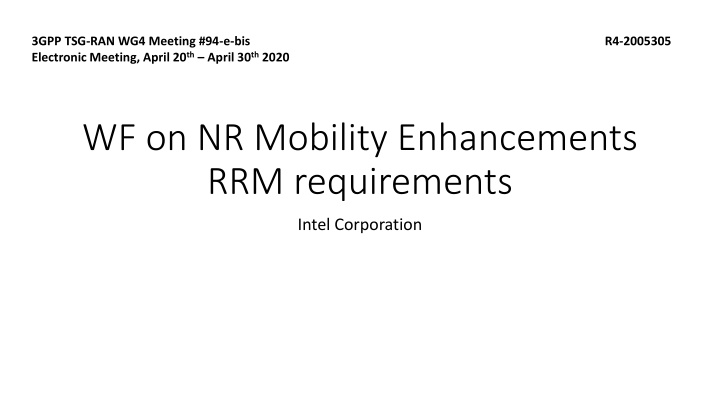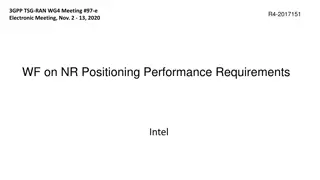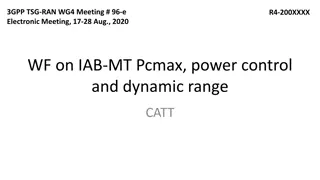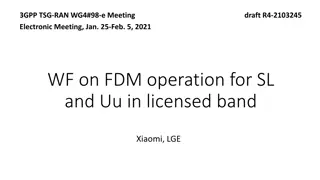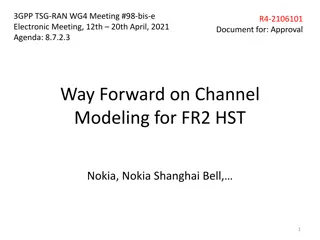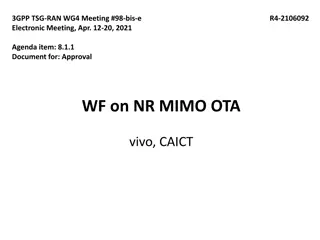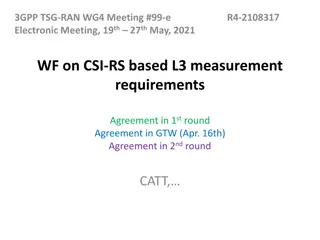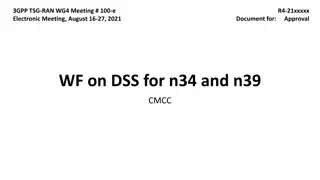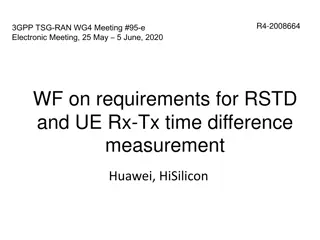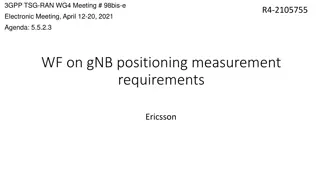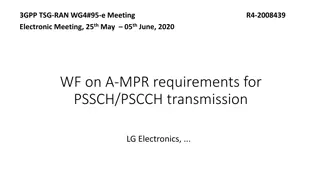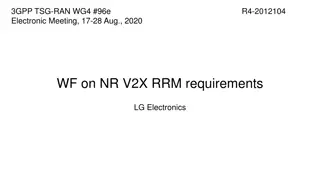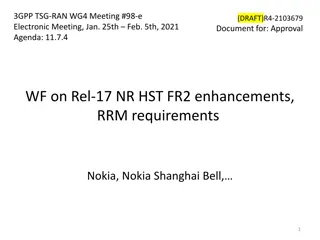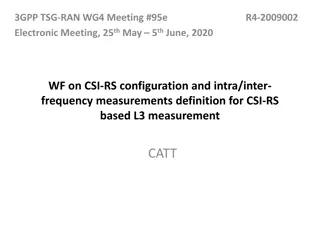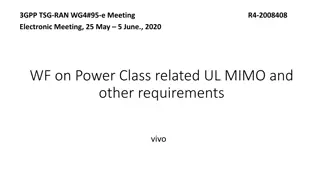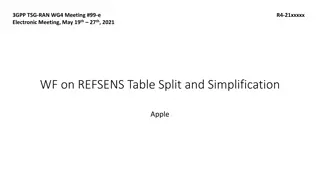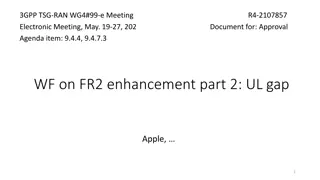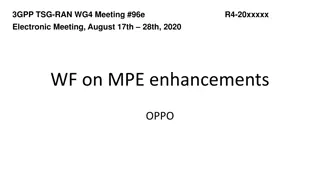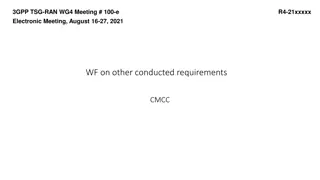3GPP TSG-RAN-WG4 Meeting #94-e-bis Electronic Meeting Summary
The summary discusses agreements and issues regarding NR Mobility Enhancements RRM requirements from the 3GPP TSG-RAN-WG4 Meeting #94-e-bis Electronic Meeting held from April 20th to April 30th, 2020. It includes details on DAPS handover agreements, interruption conditions, power imbalance, and RRM measurements. The way forward for DAPS handover in the 1st and 2nd rounds is also outlined concerning sync and async scenarios.
Download Presentation

Please find below an Image/Link to download the presentation.
The content on the website is provided AS IS for your information and personal use only. It may not be sold, licensed, or shared on other websites without obtaining consent from the author.If you encounter any issues during the download, it is possible that the publisher has removed the file from their server.
You are allowed to download the files provided on this website for personal or commercial use, subject to the condition that they are used lawfully. All files are the property of their respective owners.
The content on the website is provided AS IS for your information and personal use only. It may not be sold, licensed, or shared on other websites without obtaining consent from the author.
E N D
Presentation Transcript
3GPP TSG-RAN WG4 Meeting #94-e-bis Electronic Meeting, April 20th April 30th 2020 R4-2005305 WF on NR Mobility Enhancements RRM requirements Intel Corporation
Background Background Agreements in this way forward are based on email discussion in R4- 2005392 Email discussion summary for [94e Bis][108] NR_Mob_enh_RRM Agreements in the last RAN4#94-e meeting can be found in: R4-2002173 Email discussion summary for RAN4#94e_#50_NR_Mob_enh_RRM R4-2002224 WF on NR Mobility Enhancements RRM requirements
DAPS handover: Agreement in 1 DAPS handover: Agreement in 1st st round round Issue 1-1: Interruption in intra-frequency DAPS HO D1 for 60KHz Agreement: 4 slots Issue 1-2: interruption when UL Tx overlap in time Agreement: no need to capture this in RAN4 specification since corresponding UE behaviour has already been captured in RAN1 specification. Issue 1-3: different interruption during Delay (1) and (2) Agreement: different interruption during Delay (1) and (2) has already been considered and reflected in existing specification. RAN4 will not revisit previous agreement Issue 1-4: Power imbalance in side condition for interruption requirements Agreement: RAN4 will not capture side condition of power imbalance in core requirement. The issue can be discussed in performance part. Issue 1-8: RRM measurement during DAPS handover: Agreement: it is up to UE implementation whether to perform RRM measurement on the frequencies of source cell and target cell during DAPS handover procedure.
DAPS handover: way forward for 2 DAPS handover: way forward for 2nd nd round round Side condition for sync DAPS HO regarding MRTD/MTTD at UE side is to be introduced. If side condition is not met, async DAPS HO is assumed. UE which can only support sync DAPS HO doesn t have to meet the requirement for sync DAPS HO. Whether existing intra-frequency and intra-band inter-frequency DAPS HO requirement can apply for both sync and async scenarios is FFS and The followings will be decided in RAN4#-95-e Whether the existing interruption requirements for intra-frequency DAPS HO are only applied for sync scenario. Whether the existing interruption requirements for intra-band inter-frequency DAPS HO can be applied are only applied for async sync scenario.
DAPS handover: way forward for 2 DAPS handover: way forward for 2nd nd round round cont. cont. Side condition for intra-frequency sync DAPS HO: o UE which only support sync DAPS HO shall meet existing DAPS HO requirement as long as: - Option 1: it is assumed that source and target cells are co-located. - 3 us MRTD and 5.21 us MTTD between source and target cells is not exceeded: Note: If the receive time difference exceeds the cyclic prefix length of that SCS, demodulation performance degradation is expected for the first symbol of the slot. - Option 2: it is assumed that source and target cells can be non-co-located. - 33 us MRTD and 34.6 us MTTD between source and target cells is not exceeded Note: If the receive time difference exceeds the cyclic prefix length of that SCS, demodulation performance degradation is expected for the first symbol of the slot. - Option 3: specify Tight Sync and Loose Sync for sync DAPS handover capabilities. - Tight Sync : 3 us MRTD and 5.21 us MTTD between source and target cells is not exceeded: Note: If the receive time difference exceeds the cyclic prefix length of that SCS, demodulation performance degradation is expected for the first symbol of the slot. - Loose Sync : 33 us MRTD and 34.6 us MTTD between source and target cells is not exceeded Note: If the receive time difference exceeds the cyclic prefix length of that SCS, demodulation performance degradation is expected for the first symbol of the slot. Side condition for intra-band inter-frequency sync DAPS HO: o UE which only support sync DAPS HO shall meet existing DAPS HO requirement as long as: - Option 1: it is assumed that source and target cells are co-located. - 3 us MRTD and 5.21 us MTTD between source and target cells is not exceeded: Note: If the receive time difference exceeds the cyclic prefix length of that SCS, demodulation performance degradation is expected for the first symbol of the slot. - Option 2: it is assumed that source and target cells can be non-co-located. - 33 us MRTD and 34.6 us MTTD between source and target cells is not exceeded Note: If the receive time difference exceeds the cyclic prefix length of that SCS, demodulation performance degradation is expected for the first symbol of the slot. - Option 3: specify Tight Sync and Loose Sync for sync DAPS handover capabilities. - Tight Sync : 3 us MRTD and 5.21 us MTTD between source and target cells is not exceeded: Note: If the receive time difference exceeds the cyclic prefix length of that SCS, demodulation performance degradation is expected for the first symbol of the slot. - Loose Sync : 33 us MRTD and 34.6 us MTTD between source and target cells is not exceeded Note: If the receive time difference exceeds the cyclic prefix length of that SCS, demodulation performance degradation is expected for the first symbol of the slot.
DAPS handover: way forward for 2 DAPS handover: way forward for 2nd nd round round cont. cont. Side condition for FR1-FR1 inter-band sync DAPS HO: o UE which only support sync DAPS HO shall meet existing DAPS HO requirement as long as: - maximum of 33 us MRTD and 34.6 us MTTD between source and target cells is not exceeded. Side condition for FR1-FR2 inter-band sync DAPS HO: o UE which only support sync DAPS HO shall meet existing DAPS HO requirement as long as: - maximum of 25 us MRTD and 26.1 us MTTD between source and target cells is not exceeded.
DAPS handover: way forward for 2 DAPS handover: way forward for 2nd nd round round cont. cont. Other conditions for intra-frequency DAPS HO: Intra-frequency DAPS HO requirements apply only if the centre frequency of the SSB of the source cell and the centre frequency of the SSB of the target cell are the same, and the subcarrier spacing of the two SSBs are also the same the active BWP of source cell contains the initial BWP of source cell. the active BWP of target cell contains the initial BWP of target cell. active DL/UP BWPs of target cell is confined within the active DL/UL BWPs of source cell
